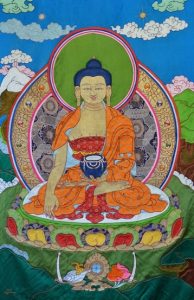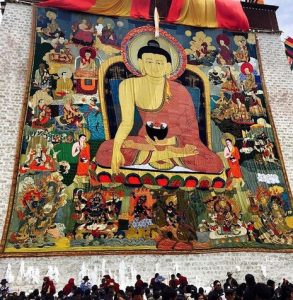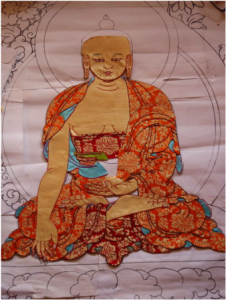About Silk Applique Thangkas
 What is a thangka?
What is a thangka?
Thangkas serve as important teaching tools depicting the life of the Buddha, various influential lamas, other deities and bodhisattvas. One subject is the (Wheel of Life), which is a visual representation of the Abhidharma teachings (Art of Enlightenment).
Vajrayana practitioners use thangka images of their yidam, or meditation deity, as a guide by visualizing themselves as a being that deity by internalizing the Buddha’s qualities within. Thangka art abides by strict rules, that are written in ancient texts and passed down from generation to generation. A great amount of study is required to create a thangka and every ornament and posture represents a particular aspect of Buddhism and its teachings.
Thangkas are also commissioned and hung to increase good fortune and ward off negative energies. In Buddhism practice, it is customary to make valuable offerings in order to increase merit and receive blessings from the Buddhas.
This sacred art is popular and beloved to Tibetans and Buddhists and interested people worldwide, because they are a representation of the enlightened potential inherent in all sentient beings.
Thangkas are also appreciated by the art community for their high level of refined skill and effort, unique techniques, exquisite materials and the finely detailed depictions of the deities portrayed.
History of silk applique thangka
Known in Tibetan as göchen thangka (precious-cloth scroll images) or göku (cloth images), the art of appliqué first began among the Huns of Central Asia to embroider saddle blankets. Gradually, it spread east across the Silk Road, and was adopted by Tibetans as a religious art form.

During the 15th century fabric thangka using indigenous appliqué technique materialised. These richly embroidered and appliquéd thangkas quickly gained popularity in Tibet.
Appliquéd thangkas are often thought of as superior to painted thangkas due to their high quality materials, durability, suppleness and their ability to last many generations. All pieces are masterfully hand stitched using special embroidery techniques.
In Tibet, the highly regarded skill of thangka making has traditionally been passed on from senior monks to the younger generation. Unfortunately, this tradition has largely been lost in Tibet. However, fortunately it has resurfaced with the exiled Tibetans in India. It is of historic importance to preserve this sacred art form, as it holds great cultural and religious significance to Tibetans and Buddhists worldwide.
Different kinds of Thangkas:
- Painted thangka
- Appliqué thangka
- Embroidered thangka
- Glued appliqué thangka.
- Woven thangka
- Block or Screen Printed on cloth thangka.
 How silk thangkas are created
How silk thangkas are created
- Firstly, a line drawing is created that has been drawn with complete accuracy, proportion and detail, of the deity or desired image.
- Then portions of the drawing are transferred by tracing to the silks that will be used in the final piece. Definition of line details is created by rolling silk thread over cord and then by carefully hand-stitching this to the silk pieces.
- The pieces are then cut out and edges turned under and ironed. Piece by piece the image is created with all its detail.
- Features such as eyes, jewels and flowers are masterfully stitched using special embroidery techniques.
- Next the individual pieces are joined together, first using a natural adhesive and then stitched along every edge so that the pieces form the completed image.
- Lastly there are some finishing stitches and additions of gems such as Tibetan turquoise and coral are added. The image is then framed in silk brocade.
- The result of the artists skill, patience, concentration and dedication is an exquisite hand stitched work of sacred art.
